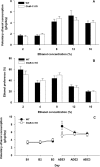Involvement of the AMPA receptor GluR-C subunit in alcohol-seeking behavior and relapse
- PMID: 16436610
- PMCID: PMC6674564
- DOI: 10.1523/JNEUROSCI.4237-05.2006
Involvement of the AMPA receptor GluR-C subunit in alcohol-seeking behavior and relapse
Abstract
Craving and relapse are core symptoms of drug addiction and alcoholism. It is suggested that, after chronic drug consumption, long-lasting neuroplastic changes within the glutamatergic system are important determinants of addictive behavior. Here, we show that the AMPA type glutamate receptor plays a crucial role in alcohol craving and relapse. We observed, in two animal models of alcohol craving and relapse, that the AMPA antagonist GYKI 52466 [1-(4-aminophenyl)-4-methyl-7, 8-methylenedioxy-5H-2, 3-benzodiazepine] dose-dependently reduced cue-induced reinstatement of alcohol-seeking behavior and the alcohol deprivation effect. The involvement of the AMPA receptor in these phenomena was further studied using mice deficient for the GluR-C AMPA subunit [GluR-C knock-out (KO)]. GluR-C KOs displayed a blunted, cue-induced reinstatement response and alcohol deprivation effect, when compared with wild-type controls; however, no differences between genotypes could be observed regarding ethanol self-administration under operant or home cage drinking conditions. These results imply a role for GluR-C in alcohol relapse, although this phenotype could also be attributable to a reduction in the total number of AMPA receptors in specific brain areas. In conclusion, AMPA receptors seem to be involved in the neuroplastic changes underlying alcohol seeking behavior and relapse. Thus, AMPA receptors represent a novel therapeutic target in preventing relapse.
Figures






Similar articles
-
Enhanced AMPA receptor activity increases operant alcohol self-administration and cue-induced reinstatement.Addict Biol. 2013 Jan;18(1):54-65. doi: 10.1111/adb.12000. Epub 2012 Nov 6. Addict Biol. 2013. PMID: 23126443 Free PMC article.
-
Morphine-induced dependence and sensitization are altered in mice deficient in AMPA-type glutamate receptor-A subunits.J Neurosci. 2001 Jun 15;21(12):4451-9. doi: 10.1523/JNEUROSCI.21-12-04451.2001. J Neurosci. 2001. PMID: 11404432 Free PMC article.
-
The effects of xenon and nitrous oxide gases on alcohol relapse.Alcohol Clin Exp Res. 2014 Feb;38(2):557-63. doi: 10.1111/acer.12264. Epub 2013 Oct 7. Alcohol Clin Exp Res. 2014. PMID: 24118055
-
Alcohol withdrawal and conditioning.Alcohol Clin Exp Res. 2005 Mar;29(3):453-64. doi: 10.1097/01.alc.0000156737.56425.e3. Alcohol Clin Exp Res. 2005. PMID: 15770122 Review.
-
Do AMPA/kainate antagonists possess potential in the treatment of addiction? Evidence from animal behavioural studies.Prog Neuropsychopharmacol Biol Psychiatry. 2025 Apr 2;138:111355. doi: 10.1016/j.pnpbp.2025.111355. Epub 2025 Apr 3. Prog Neuropsychopharmacol Biol Psychiatry. 2025. PMID: 40187601 Review.
Cited by
-
Calcium-permeable AMPA receptor activity and GluA1 trafficking in the basolateral amygdala regulate operant alcohol self-administration.Addict Biol. 2021 Sep;26(5):e13049. doi: 10.1111/adb.13049. Epub 2021 May 5. Addict Biol. 2021. PMID: 33955100 Free PMC article.
-
GluA2-lacking AMPA receptors in hippocampal CA1 cell synapses: evidence from gene-targeted mice.Front Mol Neurosci. 2012 Feb 24;5:22. doi: 10.3389/fnmol.2012.00022. eCollection 2012. Front Mol Neurosci. 2012. PMID: 22375105 Free PMC article.
-
Enhanced AMPA receptor activity increases operant alcohol self-administration and cue-induced reinstatement.Addict Biol. 2013 Jan;18(1):54-65. doi: 10.1111/adb.12000. Epub 2012 Nov 6. Addict Biol. 2013. PMID: 23126443 Free PMC article.
-
Potentiation of cerebellar Purkinje cells facilitates whisker reflex adaptation through increased simple spike activity.Elife. 2018 Dec 18;7:e38852. doi: 10.7554/eLife.38852. Elife. 2018. PMID: 30561331 Free PMC article.
-
Involvement of non-NMDA glutamate receptors in central amygdala in synaptic actions of ethanol and ethanol-induced reward behavior.J Neurosci. 2007 Jan 10;27(2):289-98. doi: 10.1523/JNEUROSCI.3912-06.2007. J Neurosci. 2007. PMID: 17215388 Free PMC article.
References
-
- Bachteler D, Spanagel R (2005). Glutamatergic compounds: preclinical data. In: Drugs for relapse prevention (Spanagel R, Mann KF, eds) pp. 205–216. Basel: Birkhäuser.
-
- Bachteler D, Economidou D, Danysz W, Ciccocioppo R, Spanagel R (2005). The effects of acamprosate and neramexane on cue-induced reinstatement of ethanol-seeking behavior in rat. Neuropsychopharmacology 30:1104–1110. - PubMed
-
- Bäckstrom P, Hyytiä P (2004). Ionotropic glutamate receptor antagonists modulate cue-induced reinstatement of ethanol-seeking behavior. Alcohol Clin Exp Res 28:558–565. - PubMed
-
- Bäckstrom P, Bachteler D, Koch S, Hyytia P, Spanagel R (2004). mGluR5 antagonist MPEP reduces ethanol-seeking and relapse behavior. Neuropsychopharmacology 29:921–928. - PubMed
-
- Broadbent J, Kampmueller KM, Koonse SA (2003). Expression of behavioural sensitization to ethanol in DBA/2J mice: The role of NMDA and non-NMDA glutamate receptors. Psychopharmacology 167:225–234. - PubMed
Publication types
MeSH terms
Substances
LinkOut - more resources
Full Text Sources
Medical
Molecular Biology Databases
Research Materials
